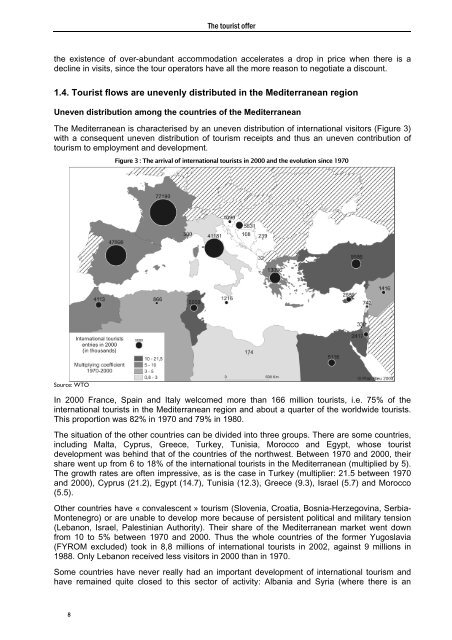dossier sur le tourisme et le développement durable
dossier sur le tourisme et le développement durable
dossier sur le tourisme et le développement durable
You also want an ePaper? Increase the reach of your titles
YUMPU automatically turns print PDFs into web optimized ePapers that Google loves.
8<br />
The tourist offer<br />
the existence of over-abundant accommodation acce<strong>le</strong>rates a drop in price when there is a<br />
decline in visits, since the tour operators have all the more reason to negotiate a discount.<br />
1.4. Tourist flows are unevenly distributed in the Mediterranean region<br />
Uneven distribution among the countries of the Mediterranean<br />
The Mediterranean is characterised by an uneven distribution of international visitors (Figure 3)<br />
with a consequent uneven distribution of tourism receipts and thus an uneven contribution of<br />
tourism to employment and development.<br />
Source: WTO<br />
Figure 3 : The arrival of international tourists in 2000 and the evolution since 1970<br />
In 2000 France, Spain and Italy welcomed more than 166 million tourists, i.e. 75% of the<br />
international tourists in the Mediterranean region and about a quarter of the worldwide tourists.<br />
This proportion was 82% in 1970 and 79% in 1980.<br />
The situation of the other countries can be divided into three groups. There are some countries,<br />
including Malta, Cyprus, Greece, Turkey, Tunisia, Morocco and Egypt, whose tourist<br />
development was behind that of the countries of the northwest. B<strong>et</strong>ween 1970 and 2000, their<br />
share went up from 6 to 18% of the international tourists in the Mediterranean (multiplied by 5).<br />
The growth rates are often impressive, as is the case in Turkey (multiplier: 21.5 b<strong>et</strong>ween 1970<br />
and 2000), Cyprus (21.2), Egypt (14.7), Tunisia (12.3), Greece (9.3), Israel (5.7) and Morocco<br />
(5.5).<br />
Other countries have « conva<strong>le</strong>scent » tourism (Slovenia, Croatia, Bosnia-Herzegovina, Serbia-<br />
Montenegro) or are unab<strong>le</strong> to develop more because of persistent political and military tension<br />
(Lebanon, Israel, Pa<strong>le</strong>stinian Authority). Their share of the Mediterranean mark<strong>et</strong> went down<br />
from 10 to 5% b<strong>et</strong>ween 1970 and 2000. Thus the who<strong>le</strong> countries of the former Yugoslavia<br />
(FYROM excluded) took in 8,8 millions of international tourists in 2002, against 9 millions in<br />
1988. Only Lebanon received <strong>le</strong>ss visitors in 2000 than in 1970.<br />
Some countries have never really had an important development of international tourism and<br />
have remained quite closed to this sector of activity: Albania and Syria (where there is an
















